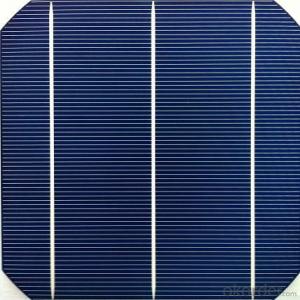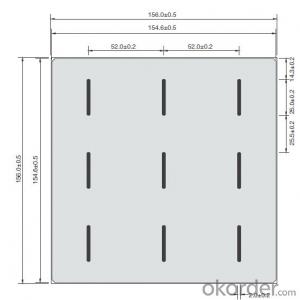Flexible Solar Cells for Sale - Mono Cell Jac M6SR-3 (Cypress2)
- Loading Port:
- China Main Port
- Payment Terms:
- TT OR LC
- Min Order Qty:
- -
- Supply Capability:
- -
OKorder Service Pledge
Quality Product, Order Online Tracking, Timely Delivery
OKorder Financial Service
Credit Rating, Credit Services, Credit Purchasing
You Might Also Like
JACM6SR-3 3BB CYPRESS2 MONO SOLAR CELL
JA solar's high effciency mono cell, manufacturing modules with more than 275W(6x10)and 325W(6x12)power putput becomes easier than ever.
Futures:
Format:156mmx156mm±0.5mm
thickness:210um±30um
Front:1.4mm bus bar(silver).blue anti-reflecting coating(silicon nitride)
back:2mm wide solding pads(silver)backsurface field(aluminum)
Data sheet

- Q: How do solar cells handle voltage fluctuations in the grid?
- Solar cells do not directly handle voltage fluctuations in the grid. However, inverters, which are connected to solar cells, play a crucial role in managing voltage fluctuations by converting the direct current (DC) generated by solar cells into alternating current (AC) that matches the grid's voltage and frequency. Inverters also have the ability to regulate voltage and synchronize with the grid, ensuring stability and safe integration of solar power into the grid.
- Q: Can solar cells be used in recreational vehicles?
- Yes, solar cells can be used in recreational vehicles. They are a popular and effective solution for powering various systems in RVs including lighting, appliances, and electronics. Solar panels can be mounted on the roof of an RV to harness sunlight and convert it into electricity, providing a reliable and sustainable source of power while on the road or during camping trips. Additionally, solar cells offer the advantage of being environmentally friendly and reducing reliance on traditional energy sources.
- Q: Can solar cells be used to power electric vehicle charging stations?
- Yes, solar cells can be used to power electric vehicle charging stations. Solar panels can generate electricity from sunlight, which can then be used to charge electric vehicles. This renewable energy source is a sustainable and environmentally friendly option for powering charging stations.
- Q: Can solar cells be used for powering space missions?
- Yes, solar cells can be used for powering space missions. Solar cells convert sunlight into electricity, providing a reliable and sustainable power source for space exploration. They have been extensively used on spacecraft and satellites to generate electricity for various systems and instruments.
- Q: Can solar cells be used on satellites?
- Yes, solar cells can be and are commonly used on satellites as their primary source of power. Solar cells convert sunlight into electricity, providing a reliable and renewable source of energy for satellites in orbit around the Earth.
- Q: What is the difference between solar cells and solar panels?
- Solar cells and solar panels are both components used in harnessing solar energy, but they have distinct differences. A solar cell refers to a single unit that converts sunlight directly into electricity through the photovoltaic effect. On the other hand, a solar panel is composed of multiple interconnected solar cells and serves as a larger unit that generates a higher amount of electricity. In summary, solar cells are individual units, while solar panels are a collection of these cells working together to generate more power.
- Q: Can solar cells be used in water pumps?
- Yes, solar cells can be used in water pumps. Solar-powered water pumps utilize solar panels to convert sunlight into electricity, which can then power the pump to draw water from a well or other water sources. This renewable energy solution is particularly beneficial in remote areas with limited access to electricity grids or where conventional power sources are expensive or unreliable.
- Q: How's the feedback of using 260 watt photovoltaic solar panel? Anybody ever used that?
- Our 260 watt photovoltaic solar panel has the highest quality, and you will always find out the positive feedback online about us.
- Q: What is the right way to operate a solar cell?
- This needs professional training in solar cell operation.
- Q: How are solar cells tested for quality?
- Solar cells are tested for quality through a series of rigorous evaluations and inspections. These tests typically involve measuring the electrical performance, efficiency, and durability of the cells. They are subjected to various environmental conditions, such as extreme temperatures and humidity, to ensure they can withstand different climates. Additionally, visual inspections are conducted to check for any manufacturing defects or physical damages. Overall, these quality tests help determine if the solar cells meet the required standards for optimal performance and reliability.
Send your message to us
Flexible Solar Cells for Sale - Mono Cell Jac M6SR-3 (Cypress2)
- Loading Port:
- China Main Port
- Payment Terms:
- TT OR LC
- Min Order Qty:
- -
- Supply Capability:
- -
OKorder Service Pledge
Quality Product, Order Online Tracking, Timely Delivery
OKorder Financial Service
Credit Rating, Credit Services, Credit Purchasing
Similar products
Hot products
Hot Searches
Related keywords




























